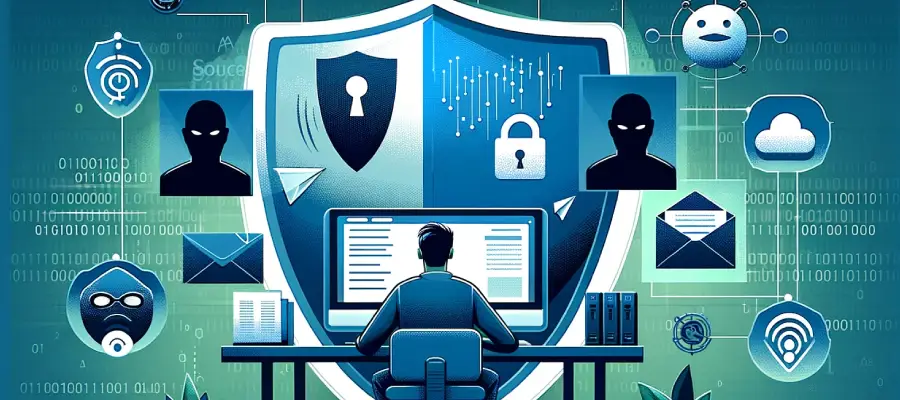How to Spot and Stop AI-Generated Frauds
Artificial intelligence can be an amazing tool and used for a lot of great things. However, there is a darker side that we should be aware of. Now, I know quite a bit about the various scams and tactics resulting in millions of dollars being stolen yearly. Well, I almost fell for a highly sophisticated AI-generated scam – almost. My close call is your gain because that close call suggests that it’s time for another security reminder.
Scams and frauds involving AI technologies, such as deepfake videos, AI-generated voice phishing (vishing), robocalls, and email scams, are not only on the rise but are getting more sophisticated. These sophisticated techniques can be highly deceptive, making it harder for individuals to distinguish between real and fraudulent. However, if someone with a security background can almost be duped, then surely those not actively on the lookout will be even more susceptible. So, here are a few ways to protect yourself against these AI-driven scams and frauds:
Understanding AI-Driven Scams
The first step is to appreciate the complexity and quality of the scams. Understand that they are quite convincing. The second step is to simply know that you will likely not see the best scams coming. That’s why they are so effective. Recent scams are using deepfake videos and AI-generated voices. However, emails are still a threat as well. Let’s break these down for clarity.
Deepfake Videos: Deepfake technology uses AI to create realistic-looking but fake videos or audio recordings of people saying or doing things they never did. These are often used in blackmail, misinformation campaigns, or to create fake endorsements. Just look at your social media feeds. They are likely filled with these. In fact, between 2019 and 2020 alone, the number of deepfakes increased by 900%, and research now suggests that some 90% of online content may be synthetically generated by 2026. Already, many have a hard time discerning real from fake videos.
Robocalls and AI-Generated Voice Phishing (Vishing): We’ve all received a call that is clearly a robot, but some are not so easy to pick out. Scammers use AI to clone voices, making calls that sound like they’re coming from a trusted person or authority, asking for personal information or money. Indeed, while technically different, Robocalls and Vishing are sometimes blurred. In fact, an interesting tactic is when they say they are from an organization you are somehow affiliated with, and because you’re their valued client, they want to enroll you in some new program. You will get a certain perk if you sign up right now. All you need to do is provide some basic information to enroll or provide an enrollment fee.
Email Scams: Email scams are not what they used to be. AI can generate very convincing phishing emails by mimicking the writing style of someone you know or customizing messages based on your online behavior. Moreover, due mainly to data mining, they sometimes have all the information necessary to overcome any objection or belay any concern before you have them.
Recognizing AI-Driven Scams
Indeed, identifying these scams can be a challenge to navigate. However, in many ways, you have to adjust your expectations to do so. The first thing is to simply accept that such technologies exist. It’s out of the tube and likely cannot be put back in it. Second, you need to appreciate that successful scams typically tug at your emotions. These can be positive or negative emotions. This works because your critical thinking is reduced when you are emotionally motivated (or manipulated).
Next, be cautious of messages or calls asking for money or sensitive information or performing urgent actions, especially if the supposed sender or caller’s request seems “off.” Look for anomalies in the video, audio, or written content that might suggest it’s AI-generated, such as awkward phrasing, unusual expressions, or mismatched lip-sync in the videos. That said, understand that even this suggestion is likely to be outdated in the very near future. After all, AI-generated content is getting better by the day.
That being said, you should always, and I mean always, verify the source of a suspicious message or call by not doing anything at the moment and contacting the person or organization directly through official channels. In fact, let me say this another way. If you feel a sense of urgency or something feels odd about the situation, just STOP! It might very well be a scam. Hang up or step away to think about it, and then call or email your representatives through the means that they had previously provided you (business card, etc.).
Protecting Yourself
If you want to take it a step further (and you should), I can offer a few additional recommendations. Of course, you should always seek to strengthen your digital hygiene. This means you use complex and unique passwords and two-factor authentication where possible. Similarly, you should ensure that you regularly update any software on your devices. These companies are continually adding security features to help protect you (and them) against vulnerabilities. In other words, don’t put that update off too long.
And I cannot stress this enough. Become the skeptic. For those who follow my work, you’ve heard me say it a million times: question with boldness EVERYTHING! Approach any unsolicited communications with extreme caution, especially if they ask for ANY kind of personal information or money. Similarly, never click on links or attachments in unsolicited emails or messages. To clarify, if you were not expecting the email, you DO NOT CLICK ON IT until you’ve called your representative to ask if that email or link is legitimate.
NOTE: You do not have to be online to be scammed via digital means. I will say this again – if you receive a suspicious call, text, or message from a number or address that is not immediately recognizable, slightly “off,” or is out of the ordinary, and especially if that message is related to some “emergency” that they want you to act on immediately, you need to verify it by contacting the person or organization through an official number or email. DO NOT HIT “REPLY!” Even if a supposed family member calls from a number that is not their own, if they are asking for money or sensitive information, hang up and call them back on the phone number you have for them or at the facility they claim to be at.
I should provide an example. A recent scam hitting the headlines targets older adults who are not up-to-speed on the latest technology. In this scam, they are contacted by their supposed grandchildren who need money because of some desperate situation. Of course, the grandparents immediately jump to action to save their grandchild, usually sending thousands of dollars to some foreign location, only to find out later that the caller was an AI-generated robocall that cloned the grandchild’s voice and the grandchild was safe at home.
Of course, we should briefly discuss fake images. You may have seen the recent headlines of various celebrities complaining about the distribution of their fake nudes. That’s AI for you. However, if you stumble upon an image that seems out of character for that person, you can always use reverse image searches for pictures or look up known scams online related to that content. Again, be the skeptic.
At the end of the day, we need to stay informed about the latest scam trends and educate friends and family on recognizing and avoiding them. That’s hard, but that’s why I’m writing this article, and I will do my best to write about them as they evolve. That said, a relatively easy way to distribute and receive that information is to participate in trusted community forums or groups that share information about scams. You can find these on almost any social media platform.
Of course, if you feel you have been targeted or have been a victim of these scams, don’t just take it. You need to report it, and this includes the highly suspicious activity that you’ve witnessed. Be sure to save what evidence you can, but report the behavior to the relevant authorities (e.g., FTC) or dedicated anti-fraud organizations. They are very interested in that information. Similarly, if you suspect you’ve been a victim of a scam, you need to alert your bank and change your security settings immediately.
Remember, as AI-generated technology becomes more advanced, so do the scams and frauds exploiting it. Creativity is key, and emotion will hinder your critical thinking. By staying informed, skeptical, and proactive in verifying sources, you can significantly reduce your risk of falling victim to these highly sophisticated scams. Remember to prioritize privacy and security in your digital life, and don’t hesitate to report suspicious activities to help protect yourself and others.
If you enjoyed this article, you might also like my article titled A Few Things To Know About Smishing




